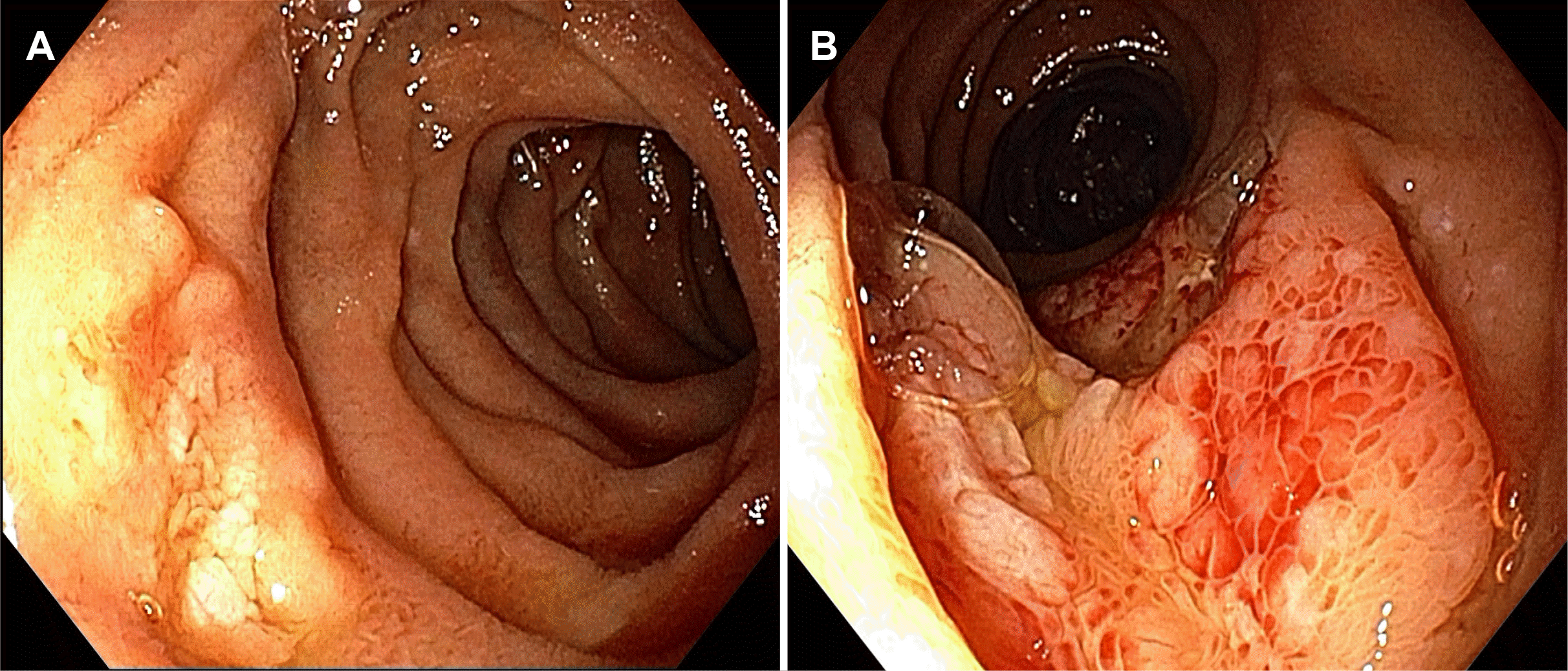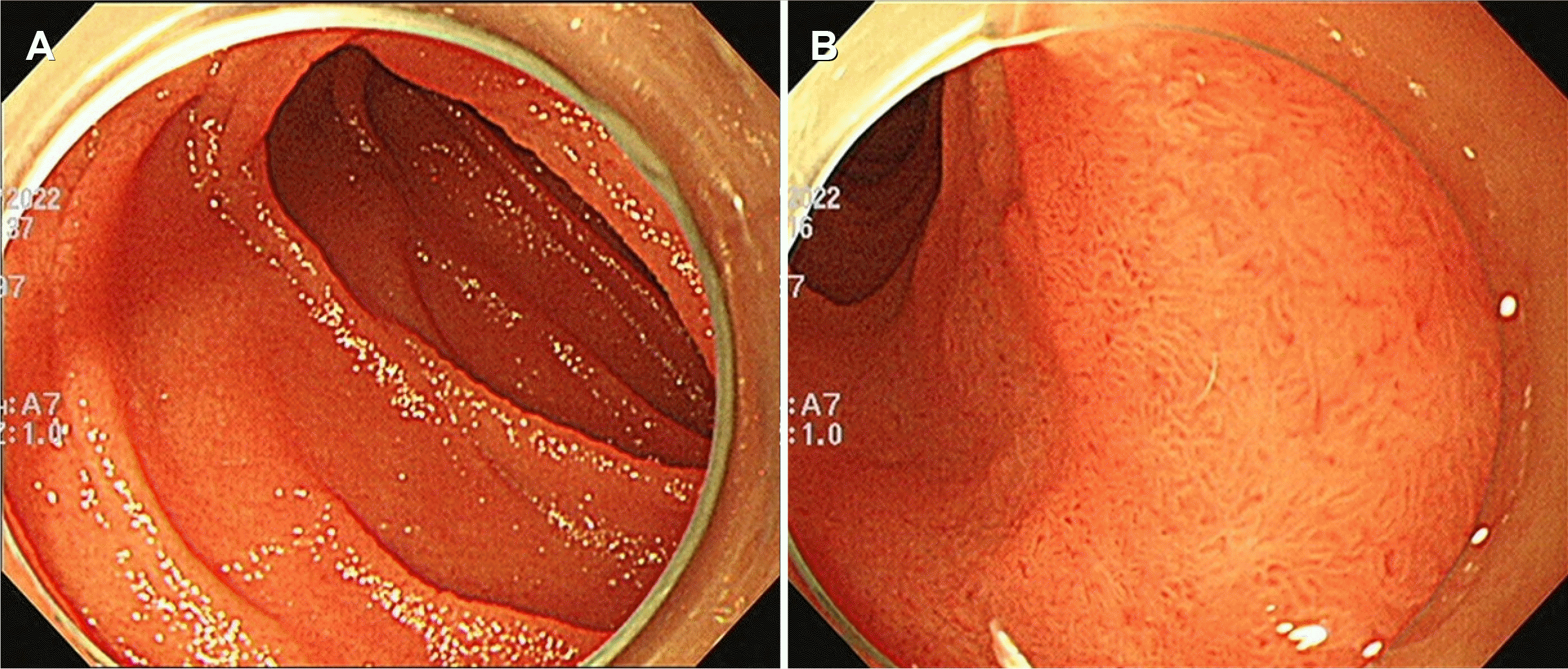A 40-year-old male visited the authors’ clinic for a medical check-up. He had no past medical history. He denied any gastrointestinal and systemic B symptoms or signs, such as abdominal pain, nausea, vomiting, fever, night sweats, and weight loss. He was afebrile, and his blood pressure and pulse rates were normal. His abdominal examination was unremarkable. The findings included a soft and non-tender abdomen, no hepatosplenomegaly, and no palpable superficial lymph nodes. The laboratory examinations revealed the following findings: white blood cell count 5,400/mm
3 (normal range: 6,000–10,000/mm
3), hemoglobin 15.7 g/dL (normal range: 12–16 g/dL), platelet count 161,000/mm
3 (normal range: 130,000–450,000/mm
3), blood urea nitrogen 12.6 mg/dL (normal range: 8–23 mg/dL), creatinine 0.85 mg/dL (normal range: 0.5–1.3 mg/dL), serum albumin 4.5 g/dL (normal range: 3.0–5.0 g/dL), aspartate aminotransferase 26 U/L (normal range: 5–37 U/L), alanine aminotransferase 21 U/L (normal range: 5–40 U/L), alkaline phosphatase 57 U/L (normal range: 39–117 U/L), or lactate dehydrogenase 335 IU/L (normal range: 218–472 IU/L). Total bilirubin was 0.89 mg/dL with a direct fraction of 0.21 mg/dL (normal range: 0.2–1.2/0.05–0.3 mg/dL). Serum carcinoembryonic antigen was within normal limits. Esophagogastroduodenoscopy showed whitish multi-nodular mucosal lesions in the second and third portions of the duodenum. The polymerase chain reaction test for
Helicobacter pylori (
H. pylori) DNA showed negative (
Fig. 1A, B). The histological examinations, including hematoxylin–eosin staining, showed dense infiltration of atypical lymphoid cells with lymphoepithelial lesions in the duodenal mucosa (
Fig. 2A). The immunohistochemical examination showed that tumor cells were positive for the B-cell marker CD20 (
Fig. 2B) and negative for CD3 and Bcl-6. The biopsy specimens indicated MALT lymphoma of the duodenum. Contrast-enhanced neck, chest, abdomen, and pelvis CT, PET-CT, and bone marrow aspiration revealed negativity for lymphoma involvement. The tumor was diagnosed as primary duodenal MALT lymphoma and classified as stage IE according to the Ann Arbor staging classification. A discussion with the multidisciplinary medical team, including a medical oncologist, radiation oncologist, gastroenterologist, and surgeon, led to the decision to perform radiation therapy. The patient received a total dose of 3,000 cGy in 15 fractions with involved site external beam radiation therapy for three weeks. Three months after the completion of radiation therapy, the esophagogastroduodenoscopy and pathologic examination revealed complete resolution of the duodenal lesions (
Fig. 3A, B). The patient has been on a regular follow-up schedule at the outpatient clinic. The serial follow-up exams with a biopsy at three months and 12 months after radiation therapy revealed no evidence of tumor recurrence. Informed consent was obtained from the patient for publication.
 | Fig. 1Esophagogastroduodenoscopy shows whitish multi-nodular mucosal lesions in the second (A) and third portions (B) of the duodenum. 
|
 | Fig. 2Microscopic findings. (A) Endoscopic biopsy specimens show dense infiltration of atypical lymphoid cells with lymphoepithelial lesions in the duodenal mucosa (H&E, ×400). (B) Immunohistochemical staining shows infiltrative atypical lymphoid cells positive for B-cell marker CD20 (×400). 
|
 | Fig. 3After radiation therapy, follow-up esophagogastroduodenoscopy shows complete resolution of lesions in the second (A) and third portions (B) of the duodenum. 
|

